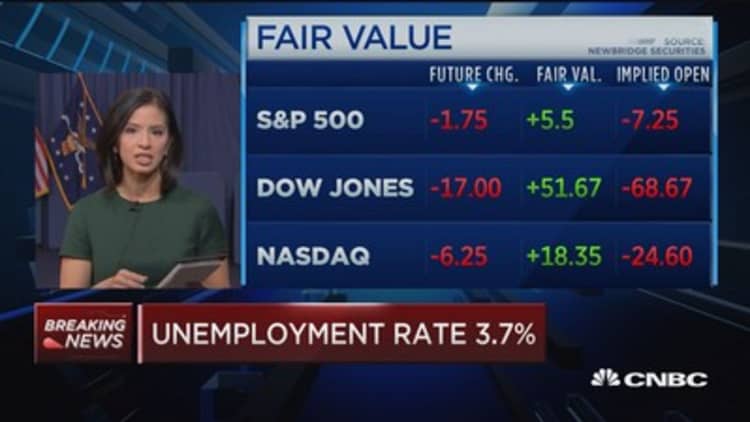Friday's jobs report, and the subsequent market reaction, is providing evidence that at least to some extent bad news is good news again.
The government's nonfarm payrolls report showed growth of 155,000, falling below Dow Jones estimates of 198,000. Though that's still a pretty healthy level of gains this late into an economic expansion, it could be enough to make the Federal Reserve hesitate about its plans to keep raising interest rates.
For the market, that's very good news. Stock futures turned positive after the report and were trading higher for most of the morning Friday before a drop in technology stocks knocked down the major indexes.
"It's not too hot, not too cold, just right for the Fed," said Satyam Panday, U.S. senior economist at S&P Global.
The reaction hearkened back to the early days of the recovery when investors hoped the Fed would keep conditions loose for as long as possible and often quietly cheered bad economic news.
"Today's jobs report does a good job signaling an economy that's still growing, yet doesn't signal any pressure for the Fed to raise rates aggressively for next year," Michael Arone, chief investment strategist at State Street Global Advisors, said in an interview. "I think the market is applauding the report."

To be sure, the Fed is still likely to approve a quarter-point rate hike at the Federal Open Market Committee meeting later this month. The market was assigning an 80 percent probability to the move Friday morning, a sharp increase from just the day before when the chances dropped to as low as 64 percent, according to the CME.
Going forward, though, the Fed may feel less compelled to keep to its schedule of three more hikes in 2019, given the slowing down of job creation and inflation that still remains around 2 percent.
"The jobs report and all other economic data have become a lot more complicated to interpret," Arone said. "On the one hand, investors are fearful of a slowdown, so they want strong economic data, while on the other hand they don't want it too strong because that concerns them that the Fed will raise rates too quickly and put us into recession."
The Fed has been watching a number of elements in the job market when formulating its policy plan.
A key one was average hourly earnings, which remained at 3.1 percent year over year in November, the highest since the recovery began in 2009. However, even that number may not convince the Fed that it needs to be aggressive in staving off inflation.
Other elements of the report showed moderation as well, with the three-month average slowing to 170,000 as the rapid pace of job growth decelerates.
"There is nothing here to panic the Fed but plenty to favor caution as the central bank seeks to deliver a soft landing and extend the business cycle," Krishna Guha, head of global policy and central bank strategy at Evercore ISI, said in a note. "We think this report will not be enough to deter the Fed from hiking in December, but it will help push lower what otherwise might have been a sticky interest rate dotplot."


